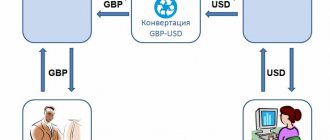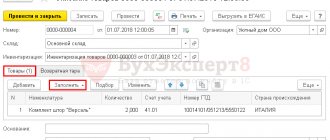What are other expenses?
The concept of “other expenses” is spelled out in the same chapter of the PBU, but in section 10/99. Here is an open list of expenses - this means that the accountant can classify as other expenses whatever he deems necessary. However, this can be done if there are no contradictions with current legislation and the accounting policies of the enterprise.
Most often, this type of expense includes:
- losses from the sale of own funds;
- expenses related to the company’s bank account;
- a fund for doubtful debts, the formation of which is the responsibility of each organization, regardless of size;
- various fines imposed on the company.
Postings to display profits and losses on account 99
In general, the accounting entry for making a profit or incurring losses in account 99 is as follows:
- Dt99 – Kt84 – retained earnings are taken into account;
- Dt84 – Kt99 – transfer of the amount of net loss;
- Dt99 – Dt90 – write-off of losses for the leading type of activity;
- Dt90 – Kt99 – reflection of profit for the leading type of activity;
- Dt99 – Kt91 – display of losses from other types of activities;
- Dt91 – Kt99 – receipt of income from other types of activities;
- Dt96 – Kt99 – increase in profit due to the balance of unused reserves;
- Dt99 – Kt10 – write-off of the cost of materials damaged as a result of emergency situations;
- Dt73 – Kt99 – recovery of expenses incurred from those responsible in emergency circumstances;
- Dt99 – Kt68 – calculation of income tax.
Profits and losses from emergency circumstances and situations include cash flows due to fire, flood, nationalization of an enterprise, natural disasters, receipt of insurance compensation, etc.
Account 91 “other income and expenses” entries and examples
In the debit of account 91 (subaccount 91.2) other expenses are recorded:
- losses associated with the sale of company property;
- interest paid on loans and credits;
- expenses for banking services for servicing accounts with credit institutions;
- fines and penalties paid by the organization;
- recognized losses of previous years;
- accounts receivable that are impossible to collect;
- negative exchange rate differences;
- other expenses listed in the instructions to the Chart of Accounts.
Subaccount 91.9 reflects the final balance for the reporting period for other income and expenses, determined by comparing the turnover in accounts 91.1 and 91.2.
Typical accounting entries 91
Let's consider the main accounting entries for reflecting business transactions with other income and expenses:
| Content | Debit | Credit |
| Receipt of PD to settlement accounts or to the company’s cash desk | 51 50 | 91-1 |
| PD for settlements with customers is reflected | 62 | 91-1 |
| PD for settlements with various debtors and creditors was taken into account | 76 | 91-1 |
| Value added tax is charged for other transactions | 91-3 | 68 |
| Reflected PR upon disposal of fixed assets | 91-2 | 01 |
| DP taken into account when disposing of inventories or raw materials | 91-2 | 10 |
| Accepted for accounting of PR for settlements with suppliers and contractors | 91-2 | 62 |
| Disposals from the company's settlement accounts for PR operations are reflected | 91-2 | 51 |
Note that accounting account 91 at the end of the reporting month should not have any balances, that is, this accounting account should be closed.
Account 91. accounting for other income and expenses. postings
The following subaccounts can be opened for it:
- 91.1 “Other income”;
- 91.2 “Other expenses”;
- 91.9 “Balance of other income and expenses.”
Income received by the organization (account 91.1) can be classified as other if they represent:
- income from the rental of its property;
- profit under a simple partnership agreement;
- income from the sale of fixed assets and other assets of the company;
- interest received under loan agreements;
- fines, penalties, and forfeit amounts transferred in favor of this organization due to violation of contract terms by counterparties;
- resulting positive exchange rate differences;
- profit of previous periods;
- expired accounts payable;
- other income other than core activities.
Such receipts are reflected in the credit of account 91.
- Dt 91 Kt 60 - attributing the shortage to other expenses after acceptance of goods from the supplier, charging penalties in favor of the supplier.
- Dt 91 Kt 01 - loss from the sale of fixed assets.
- Dt 60 Kt 91 - recognition of accounts payable (including unclaimed or expired) as income of the organization.
- Dt 76 Kt 91 - reflection of unclaimed amounts deposited for wages as income.
- Dt 10 Kt 91 - free receipt of materials.
- Postings Kt 91 Dt 91 also record the results of other income and expenses:
- Dt 91 Kt 99 - profit on other income and expenses is reflected;
- Dt 99 Kt 91 - a loss was received on other income and expenses.
Posting Debit 91 Credit 68 If it is necessary to reflect VAT on transactions not related to the main activities, use the debit of account 91.
I note that income and expenses arising as a result of emergency situations are not taken into account in this account, but are credited directly to the account. 99 "Profits and losses." Video help “Account 91. Accounting for other income and expenses” This video lesson explains how to keep accounting for other income and expenses (account 91), what subaccounts, postings and typical transactions are.
The lesson is taught by the teacher of the site “Accounting and Tax Accounting for Dummies”, chief accountant Gandeva N.V. To watch online, click on the video ⇓ Accounting for other income and expenses The debit of account 91 records expenses, and the credit records income. In its structure, 91 accounting accounts resemble an account. 90 "Sales". At the account
Wiring 96 69
Wiring 96 69
Reserves for upcoming expenses. Other income
- As of the end date of the reporting period: The balance of the reserve not used during the period is written off back to the source of its (reserve) formation; It is carried out on the basis of an accounting certificate.
- The same posting, in accordance with clause 22 of PBU 8/2010, reflects the write-off of the corresponding reserve in the accounting of exploration assets (expenses for the development of natural resources), provided that production is recognized as unpromising.
In the latter case, the previously accrued reserve (see line 2), but remaining unexhausted, is simultaneously written off: Dt 96 Kt 91.1 - the reserve is written off in accordance with clause 22 of PBU 8/2010. So, if the source of the formation of the reserve for upcoming expenses was an expense item, then, accordingly, the balance of the unused reserve should be credited to income. The only question is whether income matches expenses. Therefore, I believe that the approach according to which the balances of reserves are written off to other expenses is not sufficiently logical, regardless of what expenses these reserves were formed from - from other expenses or from expenses of core activities. In my opinion, this topic should remain in the realm of professional judgment, and not strict official regulations.
In general, the posting scheme for accounting for material exploration assets is as follows:
- Dt 08.9 Kt 02 (10, 20, 23, 60, 68, 69, 70...) - for the amount of invoiced expenses incurred in connection with work on the development of natural resources;
- Dt 08.9 Kt 96 – estimated liabilities (a reserve in the amount of the estimated cost of work on dismantling, liquidating the facility and restoring the site at the end of the facility’s service life) – are created in accordance with Section. III (clause 15-20) PBU 8/2010;
- Dt 08.10 Kt 08.9 - for the amount of costs accumulated on account 08.9 related to material exploration assets, which are accepted as such for accounting by this posting;
- Dt 23 Kt 02 - for the amount of periodically accrued depreciation of exploration assets;
- Dt 02 Kt 08.10 – for the amount of depreciation of exploration assets accumulated during exploration work (depreciation is written off against the initial cost of the corresponding exploration assets);
- Dt 01 Kt 08.10 - for the amount of the residual value of material exploration assets, provided that production is recognized as commercially viable, or Dt 91.2 Kt 08.10, if production is recognized as unpromising. In the latter case, the previously accrued reserve (see line 2), but remaining unexhausted, is simultaneously written off: Dt 96 Kt 91.1 - the reserve is written off in accordance with clause 22 of PBU 8/2010.
- 08.9 – Investments in exploration assets (expenses for the development of natural resources)
- 08.10 – Material prospecting assets.
For details on how a reserve is created in the amount of the estimated cost of dismantling, liquidating the facility and restoring the site at the end of the facility’s service life, see a separate article.
See also: Some general criteria for accounting for reserves for future expenses and payments.
Instructions 70 count
Instructions for using the chart of accounts for accounting the financial and economic activities of organizations in accordance with Order No. 94n dated October 31, 2000
Account 70 “Settlements with personnel for wages” is intended to summarize information on settlements with employees of the organization for wages (for all types of wages, bonuses, benefits, pensions for working pensioners and other payments), as well as for the payment of income on shares and other securities of this organization.
In the credit of account 70 “Settlements with personnel for wages” the following amounts are reflected:
- wages due to employees - in correspondence with accounts of production costs (selling expenses) and other sources;
- wages accrued at the expense of the reserve formed in the prescribed manner for the payment of vacations to employees and the reserve of benefits for length of service, paid once a year - in correspondence with account 96 “Reserves for future expenses”;
- accrued social insurance benefits, pensions and other similar amounts - in correspondence with account 69 “Calculations for social insurance and security”;
— accrued income from participation in the capital of the organization, etc. — in correspondence with account 84 “Retained earnings (uncovered loss).”
The debit of account 70 “Settlements with personnel for wages” reflects the paid amounts of wages, bonuses, benefits, pensions, etc., income from participation in the capital of the organization, as well as the amount of accrued taxes, payments under executive documents and other deductions.
Amounts accrued but not paid on time (due to the failure of recipients to appear) are reflected in the debit of account 70 “Settlements with personnel for wages” and the credit of account 76 “Settlements with various debtors and creditors” (sub-account “Settlements for deposited amounts”). .
Analytical accounting for account 70 “Settlements with personnel for wages” is maintained for each employee of the organization.
Typical transactions for account 70
By debit of the account
| Contents of a business transaction | Debit | Credit |
| Salaries were paid from the organization's cash register | 70 | 50 |
| Salary was transferred from the current account | 70 | 51 |
| Salary transferred from foreign currency account | 70 | 52 |
| Salary was transferred from a special bank account | 70 | 55 |
| Personal income tax is withheld from salary | 70 | 68 |
| The debt of employees for vouchers at the expense of social insurance funds is reflected | 70 | 69-1 |
| Accountable amounts issued to the employee are offset against wages | 70 | 71 |
| The amount of material damage was withheld from wages | 70 | 73-2 |
| Personal insurance payments withheld from salary | 70 | 76-1 |
| Salary not received on time deposited | 70 | 76-4 |
| The accrued salary of an employee transferred to a branch allocated to a separate balance sheet was written off (posting in the accounting of the head office) | 70 | 79-2 |
| The accrued salary of an employee transferred to the head office is written off (posting in the branch accounting) | 70 | 79-2 |
| The amount of the shortfall in excess of the norms of natural loss was withheld from the salary | 70 | 94 |
| Amounts issued on account and not returned within the prescribed period are withheld from wages | 70 | 94 |
By account credit
| Contents of a business transaction | Debit | Credit |
| Wages accrued to employees involved in construction or acquisition of non-current assets | 08 | 70 |
| Wages accrued to employees engaged in primary production | 20 | 70 |
| Salaries accrued to employees engaged in auxiliary production | 23 | 70 |
| Salaries accrued to employees engaged in production maintenance | 25 | 70 |
| Salaries accrued to employees involved in the management of the organization | 26 | 70 |
| Salaries paid to employees involved in repairing defects | 28 | 70 |
| Wages accrued to employees engaged in service production | 29 | 70 |
| Salaries paid to sales employees | 44 | 70 |
| Social benefits accrued at the expense of the Social Insurance Fund (sick leave, etc.) | 69 | 70 |
| Accrued payments due from other organizations | 76 | 70 |
| The salary of an employee transferred from a branch allocated to a separate balance sheet is taken into account (posting in the accounting of the head office) | 79-2 | 70 |
| The salary of an employee transferred from the head office is taken into account (posting in the branch accounting) | 79-2 | 70 |
| Dividends accrued to founders who are employees of the organization | 84 | 70 |
| Wages accrued to employees engaged in obtaining other income or working in non-production departments of the organization (kindergartens, holiday homes) | 91-2 | 70 |
| Salaries were accrued to employees who eliminated the consequences of emergency situations (earthquake, flood, fire, etc.) | 91-2 | 70 |
| Salary accrued from a previously created reserve | 96 | 70 |
| Wages have been accrued to employees engaged in performing work, the costs of which are taken into account in future expenses | 97 | 70 |
What does the entry Debit 91 and Credit 91 reflect?
91 accounting account is an account on which the organization’s income and expenses are recorded that are not directly related to its main activities (Order of the Ministry of Finance dated October 31, 2000 No. 94n (hereinafter referred to as the Chart of Accounts).
The following subaccounts can be opened for it:
- 91.1 “Other income”;
- 91.2 “Other expenses”;
- 91.9 “Balance of other income and expenses.”
Income received by the organization (account 91.1) can be classified as other if they represent:
- income from the rental of its property;
- profit under a simple partnership agreement;
- income from the sale of fixed assets and other assets of the company;
- interest received under loan agreements;
- fines, penalties, and forfeit amounts transferred in favor of this organization due to violation of contract terms by counterparties;
- resulting positive exchange rate differences;
- profit of previous periods;
- expired accounts payable;
- other income other than core activities.
Account 91 in accounting
A complete list of other income and expenses can be studied in the order of the Ministry of Finance of the Russian Federation dated October 31, 2000 No. 94n.
The “Other income and expenses” account is active-passive. The credit of the account reflects the receipt, and the debit records the expense:
The main subaccounts for 91 accounts are presented in the figure:
The purpose of analytical accounting for 91 accounts is to provide the ability to determine the financial result based on each type of income and expense. Consequently, when classifying income and expenses, it is necessary to take into account the homogeneous type of costs to ensure the possibility of determining the financial result for each operation of the same type.
For example, amounts under the article “Fines and penalties for contractual obligations” can be attributed to both expenses and income, therefore, the financial result under this article can be analyzed. Or, by analyzing the expense item for paying for the services of credit institutions, the enterprise will be able to see the effectiveness of working with the bank, whether the bank’s “products” are beneficial to the enterprise.
Accounting for R&D costs
Let's consider the following example: how in "1C: Accounting 8" expenses for research, development and technological work (R&D) are taken into account, how temporary and permanent differences in the assessment of R&D expenses are reflected, and how IT is recognized and repaid.
Example 2
| Modern Technologies LLC applies OSNO and PBU 18/02 as amended. Order No. 236n (balance sheet method). Through a third-party organization, the organization conducts R&D on the topic included in the List, approved. Decree of the Government of the Russian Federation dated December 24, 2008 No. 988. In February 2022, an acceptance certificate for completed work was signed with the contractor. The contractual cost of the performed R&D is 10 million rubles. (NDS is not appearing). All settlements with the contractor under the contract have been completed. The R&D carried out produced positive results that are not subject to legal protection (not intangible assets). In March 2022, the use of R&D results for management needs began. In accounting, the period for writing off R&D expenses is set at 50 months; the write-off is carried out using the straight-line method. In tax accounting, R&D costs are written off as a lump sum as part of other expenses using a coefficient of 1.5. Within the prescribed period, the organization submitted a report on the R&D performed to the tax authority. |
R&D includes work related to the implementation of scientific (research), scientific and technical activities and experimental developments, defined by the Federal Law of August 23, 1996 No. 127-FZ “On Science and State Scientific and Technical Policy.”
R&D results that are not subject to legal protection should be taken into account in accordance with the rules of PBU 17/02 “Accounting for expenses on research, development and technological work” (approved by order of the Ministry of Finance of Russia dated November 19, 2002 No. 115n). Information on R&D expenses is reflected in accounting as investments in VNA (clause 5 of PBU 17/02). Under the conditions of Example 2, all the requirements set out in paragraph 7 of PBU 17/02 are met for the recognition of R&D expenses as an independent inventory item of accounting: expenses are documented, a certificate of completion of work is signed, the work led to positive results that are used for management purposes.
Write-off of R&D expenses begins in the month following the month in which the R&D results began to be used. The methods (including linear) and the write-off procedure are specified in section IV of PBU 17/02.
The specifics of companies recognizing R&D expenses for profit tax purposes are established in Article 262 of the Tax Code of the Russian Federation. R&D expenses are expenses related to the creation of new or improvement of manufactured products (goods, works, services), the creation of new or improvement of used technologies, methods of organizing production and management (clause 1 of Article 262 of the Tax Code of the Russian Federation).
In general, R&D expenses are included in other expenses in the reporting (tax) period in which research or development (individual stages of work) are completed, regardless of the result obtained (clauses 4, 5 of Article 262 of the Tax Code of the Russian Federation). If, as a result of R&D, an object of intellectual property is created, then such expenses are taken into account in a special manner, for example, they can be recognized as intangible assets (clause 9 of Article 262 of the Tax Code of the Russian Federation).
R&D expenses, the list of which was approved by Decree of the Government of the Russian Federation of December 24, 2008 No. 988, are taken into account in the amount of actual costs using a coefficient of 1.5 (clause 7 of Article 262 of the Tax Code of the Russian Federation). In this case, a taxpayer using a coefficient of 1.5 is required to submit a report on the R&D performed to the tax authority. The organization is obliged to do this simultaneously with the submission of a declaration based on the results of the tax period in which the relevant research and development (their individual stages) was completed.
The report must comply with GOST 7.32-2001 (introduced by Decree of the State Standard of Russia dated September 4, 2001 No. 367-st) and must be submitted in relation to each research or development. Moreover, if stage-by-stage implementation of R&D is envisaged and these stages fall in different years (tax periods), separate Reports must be submitted in relation to such stages (see also letters of the Ministry of Finance of Russia dated 08/07/2013 No. 03-03-10/31889, Federal Tax Service of Russia dated 09/09 .2013 No. ED-4-3/ [email protected] ).
| 1C:ITS For more information on accounting for R&D expenses, see the reference book “Organizational Income Tax” in the “Legislative Consultations” section. |
Operations 2022
Under the terms of Example 2, in February 2022, the organization completed R&D and signed a work acceptance certificate with the contractor. Acceptance of R&D is registered in the accounting system with the document Receipt of intangible assets (section OS and intangible assets).
In the header of the document you should indicate the name of the counterparty, the agreement with the counterparty, check the accounting accounts and settlement terms using the link in the Settlements field.
In the tabular part of the document, you should indicate the name of the object (selected from the directory), the amount and VAT rate (without VAT).
Please note that the same directory is intended for storing intangible assets and R&D objects - Intangible Assets (section Directories). Since, under the conditions of Example 2, the results of R&D are not subject to legal protection and an object of intellectual property is not created, then in the intangible asset card it is necessary to select the type of accounting object - R&D Expenses (Fig. 4).
Rice. 4. R&D card
In this case, in the document Receipt of intangible assets, to account for R&D costs, account 08.08 “Performance of research, development and technological work” is automatically set.
After posting the document, the following transactions are generated:
Debit 60.01 Credit 60.02 - for the amount of offset of the advance payment to the supplier (RUB 10,000,000);
Debit 08.08 Credit 60.01 - for the cost of R&D costs (RUB 10,000,000).
For tax accounting purposes, the corresponding amounts are reflected in special fields of the accounting register Amount Dt NU: and Amount Kt NU:.
Since temporary differences are not recognized in the balance sheet accounts in February 2022, deferred tax assets and liabilities (TTA and TTO) are not recognized.
In March 2022, R&D that begins to be used in production activities is taken into account. Recognition of R&D expenses is registered by the document Acceptance for accounting of intangible assets (section OS and intangible assets) with the type of accounting object R&D expenses (Fig. 5).
Rice. 5. Recognition of R&D expenses
On the Non-current asset tab, you must indicate the name of the R&D, and the accounting account 08.08 is set automatically. Clicking the Calculate amounts button will automatically calculate the amount of R&D costs based on accounting and tax accounting data (RUB 10,000,000). Permanent and temporary differences by type of assets and liabilities Non-current assets have not been identified.
On the Accounting tab (Fig. 6), accounting account 04.02 “Expenses for research, development and technological work” is automatically installed. The user will be required to specify the parameters for writing off expenses:
- set the Write off expenses flag;
- in the Method of writing off expenses field, select the value Linear;
- select a method for reflecting R&D expenses from the Methods for Reflecting Expenses directory. For expenses included in other expenses with a coefficient of 1.5, the method of reflecting expenses indicates an expense item with the type of R&D according to the list of the Government of the Russian Federation;
- indicate the write-off period in months.
Rice. 6. Recognition of R&D expenses
On the Tax Accounting tab, in the Procedure for writing off expenses field, select the value When accepted for accounting.
When posting a document, two accounting register entries are generated.
- Recognition of R&D expenses as an independent accounting object:
Debit 04.02 Credit 08.08 - for the amount of costs incurred (RUB 10,000,000).
At the same time, special fields of the accounting register are filled in:
Amount Dt BP: 04.02 - for the amount of the temporary difference (RUB 10,000,000); Amount Kt NU: 08.08 - for the amount of (RUB 10,000,000).
- Inclusion of R&D expenses in other expenses:
Debit 26 Credit 08.08 - with the Amount field blank.
In this case, special fields of the accounting register are filled in:
Amount Dt NU: 26 - for the amount of recognized R&D expenses with a coefficient of 1.5 in tax accounting (RUB 15,000,000); Amount Dt PR: 26 - by the amount of the constant difference with a minus sign (-5,000,000 rubles). The specified difference does not represent the difference between the book value of the asset (R&D expenses) and its value accepted for tax purposes, therefore it is automatically qualified by the program as a permanent difference (PR); Amount Dt BP: 26 - for the amount of temporary difference with a minus sign (-10,000,000 rub.).
When performing the routine operation Closing accounts 20, 23, 25, 26, which is included in the processing of Closing the month for March 2022, the amount of R&D expenses recognized in tax accounting with a coefficient of 1.5 is taken into account in administrative expenses, which is reflected by correspondence:
Debit 90.08.1 Credit 26 - with the Amount field blank.
In this case, special fields of the accounting register are filled in:
Amount Dt NU: 90.08.1 and Amount Kt NU: 26 - for the amount of management expenses in tax accounting (RUB 15,000,000); Amount Dt PR: 90.08.1 and Amount PR NU: 26 - for the amount of the identified permanent difference with a minus sign (-5,000,000 rub.); Amount Dt BP: 90.08.1 and Amount Kt BP: 26 - for the amount of the identified temporary difference with a minus sign (-10,000,000 rubles).
When determining financial results (regular operation Closing accounts 90, 91), temporary and permanent differences are also recorded in special fields of the accounting register:
Amount Dt PR: 90.09 and Amount PR NU: 99.01.1 - for the amount of the permanent difference (5,000,000 rubles) ; Amount Dt BP: 90.09 and Amount Kt BP: 99.01.1 - for the amount of the temporary difference (RUB 10,000,000).
Let's analyze permanent (PD) and temporary differences (TD) identified in March 2022 and reflected in the accounting accounts in special resources of the accounting register:
- BP, reflected in the debit of account 26 “General business expenses”, is repaid in the same month at the end of the month (passes through “transit”), therefore does not lead to the formation of transactions on accounts 09 and 77;
- BP reflected in the subaccounts of account 90 “Sales” also does not lead to the recognition or repayment of IT and IT.
Thus, the formation of deferred tax will be affected only by the balance of temporary differences reflected in account 04.02 (RUB 10,000,000). The balance of accounts 04 and 05 corresponds to the type of assets and liabilities Intangible assets. This difference is taxable, since the book value in accounting for the type of asset Intangible assets exceeds its value accepted for tax purposes.
When performing a regulatory operation, Calculation of deferred tax according to PBU 18/02 for March 2022 is recognized as IT by type of assets and liabilities Intangible assets:
Debit 68.04.2 Credit 77 - in the amount of 2,000,000 rubles. (RUB 10,000,000 x 20%).
In addition, permanent tax income is recognized:
Debit 68.04.2 Credit 99.02.3 - in the amount of 1,000,000 rubles. (RUB 5,000,000 x 20%).
Fixed tax expense (income) is calculated as the product of the balance of permanent differences in the taxable profit account (99.01.1 “Profits and losses from activities with the main taxation system”) and the current tax rate. Analytical accounting of permanent tax expense (income) by type of assets and liabilities is not required and is not supported.
Starting from April 2022, R&D expenses begin to be written off in accounting. Please note that account 05 “Amortization of intangible assets” is not used to write off R&D expenses.
This operation is reflected in accounting by an entry on the credit of account 04 in correspondence with the debit of the production cost accounts (20, 26) (see the Chart of Accounts for the accounting of financial and economic activities of organizations and the Instructions for its application, approved by order of the Ministry of Finance of Russia dated October 31 .2000 No. 94n).
When performing the routine operation Depreciation of intangible assets and write-off of R&D expenses, which is included in the Month Closing processing, in April 2019 the following accounting entry is generated in the information base:
Debit 26 Credit 04.02 - for the amount of write-off of the cost of R&D (10,000,000 rubles / 50 months = 200,000 rubles).
In tax accounting, R&D expenses have already been written off, so temporary differences are automatically calculated (200,000 rubles - 0 rubles = 200,000 rubles), which are recorded in the fields:
Amount Dt BP: 26 and Amount Kt BP: 04.02.
In April 2022, the balance of temporary differences by type of assets and liabilities Intangible assets decreases by RUB 200,000.
When performing a regulatory operation Calculation of deferred tax according to PBU 18/02 for April 2022, recognition of deferred tax liability by type of assets and liabilities Intangible assets is reversed:
REVERSE Debit 68.04.2 Credit 77 - in the amount of 40,000 rubles. (RUB 200,000 x 20%).
As the amount of R&D expenses is gradually written off in accounting, the balance of temporary differences will gradually decrease.
By the end of 2022, the temporary difference in the type of assets and liabilities Intangible assets will amount to RUB 8,200,000, IT will be recognized in the amount of RUB 1,640,000. (RUB 8,200,000 x 20%).
In the balance sheet for 2022, the amount of deferred tax liabilities is reflected on line 1420 (RUB 1,640 thousand). In the income statement, changes in deferred tax liabilities are reflected in line 2430 (RUB 1,640 thousand).
Why are loss standards needed?
Account 94 “Shortages and losses from damage to valuables” influences the formation of expenses. It displays:
- Deficiencies identified during the inventory.
- Damage resulting from damage to company property.
This account is active-passive, so it can have debit and credit balances. The debit collects lost property in total terms. Depending on the amount of losses, there are certain indicators, based on which the company writes off its damage:
- within the limits of natural loss;
- above the norms of natural loss with the appointment of a responsible person;
- above the norms of natural loss without a specific culprit.
Natural loss is the property’s ability to shrink, shrink, rot, break dishes and other factors beyond the control of the carrier, supplier or storekeeper.
For each such product in trade there are standards within which shortages and losses are acceptable. For example, when transporting peaches, a certain amount may be crushed in the container, since this is a very delicate product, and there are potholes and potholes on the roads.
To prevent this factor from being used for theft purposes, a specific standard has been established for the product. Loss in excess of the required standard is regarded as theft or intentional damage. Natural loss is calculated using the formula:









